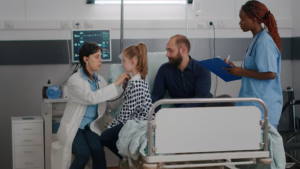The Future of Paramedics in Allied Health: Expanding Roles & Opportunities
When you hear the wail of a siren or see an ambulance cutting through traffic, your first thought may be of the patient being whisked inside — not the paramedic behind the wheel.
But these frontline healthcare heroes are also in the midst of a quiet revolution — a revolution that has the potential to redefine their role in medicine, expand their impact at the community level, and help shape the future of allied health.
Intervening on highways and providing preventative services in living rooms, paramedics are entering unfamiliar territory. Let’s take a look at how this vital profession is transforming and why its future is more promising — and more complicated — than ever.
From Emergency Responders to Healthcare Innovators
For more than three decades, paramedics have defined emergency medicine. They’re the steady voices in frantic moments, the anchoring hands that stabilize trauma patients and the first responders to heart attacks, accidents and disasters.
But as health care systems across the globe wrestle with soaring costs, aging populations, and access gaps, they are increasingly calling on paramedics to do more.
Think about this: By 2030, nearly 20% of the U.S. population will be older than 65, according to the U.S. Census Bureau. Older adults disproportionately have chronic conditions such as diabetes, heart disease, and mobility problems — conditions often requiring frequent hospital visits.
With their specialized ability to assess and treat patients quickly, paramedics are increasingly being enlisted to address those challenges outside of traditional emergencies.
In something like community paramedicine. This expanding model has paramedics dispatch to the homes of high-risk patients to deliver in-home care, which helps prevent unnecessary ER visits.
Community paramedics in one Minnesota program cut hospital readmissions by 25% within six months by visiting patients after their discharge and coordinating with primary care providers. These projects underscore a seismic shift: For paramedics, they are no longer just crisis responders — they’re becoming proactive caregivers.
Technology’s Double-Edged Sword
Technological changes are affecting every aspect of healthcare, and paramedicine is no different. [Predicting the Future: EHRs and the Future of Medical Records]Newer innovations such as telemedicine, wearable devices, and AI-driven diagnostics are providing paramedics with tools that would have been viewed as science fiction only a decade ago.
Think of a paramedic who comes upon a cardiac arrest scene. Instead of depending on a physical exam alone, they employ a handheld ultrasound device that sends images via live video to an emergency physician.
This allows the physician to lead them remotely during the diagnosis process and enhance their accuracy. This isn’t hypothetical — it’s happening right now. A 2023 study in the Journal of Emergency Medical Services discovered that 58 percent of U.S. E.M.S. agencies had incorporated telemedicine into their workflows, reducing delays in treatment for stroke and heart attack patients.
But technology also brings complications. Paramedics Today must be able to operate advanced equipment, interpret data from wearables, and navigate electronic health records while keeping the human touch that makes the work of paramedicine human.
Training programs are evolving, with simulation labs and virtual reality now commonplace in paramedic training. Even so, balancing tech dependence with manual know-how is a tightrope act.
Expanding Scope of Practice
In many places, paramedics are gaining the authority to carry out procedures that were once the domain of doctors. Some Australian paramedics now write prescriptions for minor ailments; in parts of Canada, they give antibiotics for UTIs. These changes aren’t merely for convenience — they are a response to overburdened hospitals and physician shortages.
Forty-seven percent of rural communities in the U.S. depend solely on volunteer EMS services, according to the National Rural Health Association. Enable paramedics to deal with low-acuity cases, and health systems can reserve ERs for patients who need them. One pilot program in Colorado successfully had paramedics resolve 80 percent of non-emergency 911 calls on-site, decreasing ER overcrowding by 15 percent.
But expanded scopes of practice bring up questions. To what degree should paramedics practice medicine independently? What are the protections put in place for patient safety? The answers are training, established protocols, and cross-discipline collaboration.
Mental Health: The Silent Crisis
Paramedics save lives, but are the unsung survivors themselves. Repeated trauma exposure, long shifts, and the pressure of split-second decisions take their toll.
An International Association of Fire Fighters survey found that 37 percent of paramedics have symptoms of PTSD, a rate higher than that of military veterans.
Addressing this crisis is critical to the future of paramedicine. Agencies are implementing peer support programs, requiring mental health screenings, and providing apps that link paramedics to therapists. In the U.K., a so-called “trauma risk management” system decreased rates of PTSD by 40 percent, with the key being early intervention.
But what is required are systemic changes. The profession needs better staffing ratios and shorter shifts and needs to start acknowledging the emotional toll of being a paramedic.
Education: Bridging the Gap Between Street Smarts and Degrees
Paramedicine is on a journey from a trade to a profession. Though hands-on experience is still critical, many countries now demand bachelor’s degrees in order to get paramedic certification.
Australia and Canada, in fact, have pioneered this shift, and multiple studies demonstrate that degree-educated paramedics commit fewer clinical errors and adjust to change initiatives more rapidly.
The push for higher education in the U.S. is picking up pace. The National Registry of Emergency Medical Technicians plans to require an associate’s degree for paramedic licensure in 2030. Critics say this could exacerbate workforce shortages—just 12 percent of U.S. paramedics now have a bachelor’s degree. But proponents say standardized education will professionalize the field and prepare paramedics to take on advanced roles.
The Rise of Specialized Paramedics
As healthcare becomes more complex, so too does paramedicine. Other specializations, such as critical care and neonatal transport, and tactical EMS (working with law enforcement during crises) are on the rise, too.
Flight medics, who extract patients from far-flung areas, receive intensive training in altitude physiology and advanced trauma care. Disaster response is an additional frontier.
As climate change ignites wildfires, floods, and pandemics, paramedics are being trained to perform in mass casualty triage, hazmat decontamination, and even field surgery.
After Hurricane Katrina, the U.S. built Disaster Medical Assistance Teams (DMATs): mobile units of paramedics, nurses, and physicians. As well as enabling paramedics to save lives, such niches provide an opportunity for career progression.
A Global Perspective on Paramedics
The evolution of paramedicine has not been uniform throughout the world. Many communities in low-income countries have no access to basic EMS.
According to the World Health Organization, 50% of the population of Africa does not have access to emergency care. Groups such as the Global Paramedic Alliance are working to address this gap by training local responders and giving them equipment.
Low- and middle-income countries, however, are not the only ones grappling with challenges; high-income countries are as well.
In Japan, which has a super-aged society, paramedics also deliver groceries and check up on isolated seniors; it’s a model that brings together health care and social support.
More Than a Job—A Lifeline
Paramedics have always been the unseen lifeline of our healthcare system, bringing people back from the edge in their most crucial moments. But their effects go well beyond flashing lights and high-speed rescues.
They are transforming themselves into educators and public health advocates and innovators, filling the gaps in care with skill, compassion, and unwavering commitment.
A changing landscape of allied health is leading paramedics to reshape what it means to serve in the front row. They are not only the first responders, they are defining the future of healthcare itself.
Whether they’re keeping people out of the ER through community paramedicine, deploying to disaster zones, or specializing in advanced critical care, the work they do has never been more crucial — or more fast-changing.
If you are passionate about the evolving landscape of paramedicine and interested in ways to break into allied health careers, check out StaffDNA. From discovering new career options to getting a jump on industry trends, Staff DNA is your guide to the future of healthcare.
Check out these other great Staffdna articles

Hospitalist Jobs vs. General Physician Assistant Jobs: What’s the Difference?
When medical professionals are considering their career options, the first things that come to mind are either hospitalists or general physician assistants.

Busting Myths About PRN Nursing Jobs: Pros, Cons & How to Find the Best Shifts
PRN nursing jobs have become a favorite among medical professionals looking for flexibility and higher pay. Yet, many misconceptions exist about PRN positions that scare some nurses away from considering it as a career choice.

How to Handle the Pressure of PACU Nursing Jobs Without Burning Out
Nursing is a demanding field, which becomes even more challenging when it comes to PACU nursing jobs.

How to Transition from Staff Nurse to A Travel Nurse
If you are a Registered Nurse with a strong desire to travel to different locations and save lives, you can be a travel nurse.

Travel Nursing: How to Choose the Best Career Assignments
Travel nursing is one way for nurses to work through new locations while also building their skill sets.

Understanding the PICU: A Guide for PICU Nurses
The pediatric intensive care unit (PICU) is a specialized department in hospitals and medical facilities. It is made to provide intensive care to infants, children, and adolescents with severe medical conditions.
